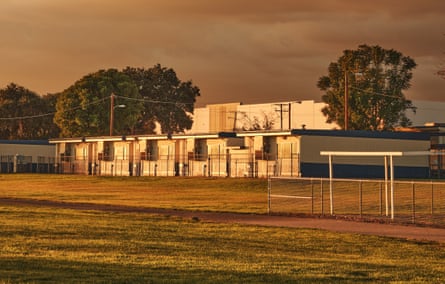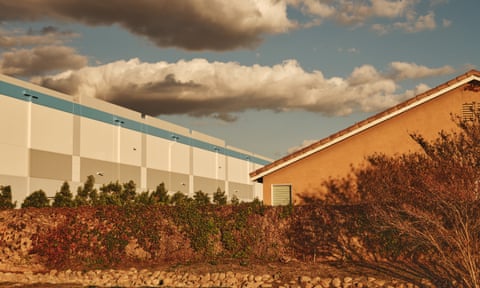When Ana Carlos looks past the horse stables behind her home, over the back fence and out across the wide open field and scrub-covered hill that blooms bright orange in the springtime, she feels dread.
Soon it will be paved over, transformed into a 213-acre industrial complex with three vast warehouses. Nearly 100 of Carlos’s neighbors’ homes in the tiny, once rural town of Bloomington, California, will be razed to make way for the development, as will the local elementary school.
“That’s like a slow death, huh? Just seeing one block go down at a time,” she said. “Until everything I see here would be just a wall of warehouses.”
Over the past decade, warehouses for online retailers as well as logistics and distribution companies such as Amazon, UPS and FedEx have reshaped southern California’s landscape. To satiate a growing hunger for one-click, doorstep delivery, colossal structures to store and sort our online orders have risen across the region.

About 1,100 warehouses have been constructed since 2010, encompassing more than 12,500 acres, according to a data tool developed by researchers at the Robert Redford Conservancy for Southern California Sustainability at Pitzer College and Radical Research. The data, shared exclusively with the Guardian, for the first time maps this sprawl of warehouses across the region and estimates their impact on the local environment.
It reveals that:
Overall, there are about 9,500 warehouses in the region with a footprint above one acre.
Each day, more than 1m truck trips out of these warehouses cloud the air with 1,450lbs of toxic diesel particulate pollution and 164,000lbs of nitrogen oxide pollution, which are linked to health problems including respiratory conditions.
The trucks also emit just under 100m lbs of carbon dioxide each day.
Across the region, about 340 school campuses are located within 1,000ft of a warehouse property line.
The new warehouses radiate out from two of the busiest US ports in Los Angeles and Long Beach, along a network of highways and rail lines. They are concentrated in the Inland Empire region, east of LA, in cities such as Ontario, Rialto and Fontana. The logistics warehouse boom has also hit LA county cities including Industry, Commerce, and Carson, which have long been industrial hubs.
The data tool was created to help residents, policy makers and planners estimate how many warehouses are within a city or neighborhood, and account for their cumulative effect on communities.
Many of these cities have majority Latino populations, and some encompass historically Black communities. A joint investigation by Consumer Reports and the Guardian last year found that the rapid expansion of warehousing in the Inland Empire and in communities across the US disproportionately affected poorer people and people of color.

Emissions from warehouse operations contribute to some of the worst air pollution in the US. A report from the local air quality monitoring management district found that people living within half a mile of warehouses have higher rates of asthma and heart attacks than residents in the area overall.
And yet, warehouses have continued to multiply, with a patchwork of city councils and other local authorities continuing to consider new projects. “It has created these Frankenstein neighborhoods where warehouses bump up against schools, homes and habitats,” said Susan Phillips, a professor of environmental analysis and director of the Redford Conservancy.
In towns such as Bloomington, Ontario and Rialto, the warehouses have encroached on neighborhoods, sending fleets of trucks thundering through residential streets.
“Sometimes it’s more than encroachment,” said Phillips. “Sometimes it can feel like a takeover.”
In Bloomington, Carlos and her neighbors had been fighting the project for years. Last month, the equestrian town staged a protest on horseback. Carlos’s teen son, who grew up participating in local cabalgatas with his dad, joined a procession of nearly 100 cowboys.
Carlos, her two younger kids, and dozens of other residents followed on foot, singing and chanting: “Bloomington united will never be defeated.”
A week later, the county board of supervisors unanimously approved the 213-acre Bloomington Business Park. “We have to look at each project individually, the pros and cons,” said the San Bernardino county board of supervisors chairman, Curt Hagman, adding that the logistics industry accounted for a large part of California’s economy and for the regional economy.
‘This is the future for our children’
Signs still tied on to fences around town read, in English and Spanish: “Bloomington is not for sale.” But now, some residents are beginning to resign themselves to the reality that it might be.
In recent years, a developer had convinced dozens of Carlos’s neighbors to sell their homes to make way for the new warehouses. Then the local school district agreed to relocate the local Zimmerman elementary as well, in exchange for $45m to rebuild a few blocks away from the coming warehouses.
Now, warehouse developers are speculating in neighborhoods around the upcoming project, seeking to buy up even more homes – or rather, the land underneath them. “I don’t think they’re ever going to build the new Zimmerman,” said Caitlin Towne, who teaches at the local middle school and grew up in town. Because soon, she worries, there won’t be enough families left in Bloomington.

Eduardo Perez, who lives adjacent to the site of the Bloomington Business Park project, has already received offers from warehouse developers, looking to annex his neighborhood. “It just doesn’t make sense for me to stay,” he said. He moved to Bloomington more than a decade ago so that his kids could grow up in a quiet, rural community – one that is quickly falling away around him.
The warehouses have already overtaken neighborhoods east of his home, where a frenzy of new construction has clustered along existing warehouses for Amazon. Even more mega warehouses, including a FedEx hub, snake along Bloomington’s border with neighboring Rialto. Big rigs and semitrucks crisscross along the wide streets cutting through south Bloomington, encircling a cluster of ranch homes. The traffic billows plumes of dust that settles atop eyelashes and creeps under fingernails.
Perez works in the logistics industry himself, for a company that refurbishes products for resale and helps brands manage online returns. Unless the industry rethinks how sales and distributions work, Perez anticipates there will be a need for more warehouses.
“Nobody wants warehouses in their neighborhood,” he said. “And yet we can’t wait for our next day’s delivery. We love Black Friday and Cyber Monday and all of that.”
“They are taking away our future, little by little, with these constructions,” said Juan Díaz, a construction worker who has lived in Bloomington for 17 years. Since the warehouse boom struck the region, Díaz has been busy – helping build many of the warehouses he worries will soon swallow up his small town life. In the neighboring town of Ontario, he recently worked on a 4.1m-square-foot construction that will become the largest Amazon warehouse in the world.
Often, the developers proposing these projects, and the local officials approving them, emphasize the job opportunities these warehouses will bring – including for contractors and construction workers. But Díaz said he didn’t understand why schools, houses, and communities have to be destroyed in order to build something new.
He was shocked when the local school district agreed to relocate the elementary school that both his sons attended.
The new school would be located across the street from a new commercial center that includes a truck stop. “This is the future for our children,” Díaz said, shaking his head.
“It feels like the area is getting suffocated,” he added. “Like they are closing everything in, obstructing the oxygen from you.”
Díaz’s wife, Leticia, has literally struggled to breathe. She has had a persistent cough for the past year, for which she has had to seek various inhaler and nebulizer treatments. Their neighbor, Maria Solis, 70, has asthma as well. So do several others in their community.
Their neighborhood is in the 83rd percentile for asthma in California. Within just a 5km radius of the Díazes’ and Solises’ neighborhood, the data tool identifies at least 150 warehouses, and the truck trips out of them emit more than 45lbs of diesel particulate matter and more than 5,200lbs of nitrogen oxide pollution each day, according to data from Pitzer and Radical Research. When nitrogen oxides mix with other pollutants in vehicle exhaust and bake under the sun, it creates ozone pollution that can trigger asthma, COPD and other health conditions.

The data tool underestimates the amount of pollution warehouse operations contribute, as it doesn’t account for emissions from trucks idling at or near warehouses. It also doesn’t include emissions from smaller delivery vans, local rail lines and airplanes that – alongside medium- and heavy-duty trucks – move an unfathomable array of consumer goods through the region each day.
Neighbors fight back but ‘can feel powerless’
Because Bloomington is an unincorporated town rather than a city with its own government, county officials rather than locally elected council members have a final say in approving warehouse projects. In nearby Riverside, Mike McCarthy, the atmospheric scientist who developed the data tool, has been working with neighbors to oppose a proposed plan to open up 9m sq ft of land that was formerly used by the March air force base for warehouse development.
That property, which currently encompasses an expanse where local residents hike, run and mountain bike, is overseen by a special land use authority, called the March Joint Powers Authority (March JPA).

Since 2010, the March JPA has approved the construction of more than 35 new warehouses, including a 2m-sq-ft development. The cities of Riverside, Perris and Moreno Valley, which border the air force base, have seen more than 100 warehouses built over that time period. The huge block buildings cluster to create labyrinths of beige and gray, inlaid with wide, characterless streets.
And while several cities, including Riverside, have issued temporary warehouse moratoriums over the past two years, the overall pace of warehouse construction in southern California has hardly slowed. Riverside developed new standards for warehouse projects after a 2020 moratorium on development in its Northside neighborhood, but has approved several warehouses since.
A state bill that would have required cities within the region to enforce a 1,000ft buffer zone between new warehouse projects and homes, schools, playgrounds, healthcare centers, churches failed to advance.
“Across this region, individual community groups are fighting dozens of these battles against warehouse proposals across different land use agencies,” said McCarthy. “And even in cases where neighborhood groups are wealthy, politically connected, organized – we can still end up feeling powerless.”
The commission has yet to vote on the proposed project on the former air force base. If it is approved, some homes in McCarthy’s neighborhood would be surrounded by warehouses in three directions.

But some residents worry that local leaders see the region’s transformation as inevitable. The Riverside city council member Chuck Conder, who also serves on the March JPA commission, said of the Inland Empire, at a May community meeting: “We’re a logistics center. That’s what we’ve become.”
Conder told the Guardian that he has not decided on the project yet.
McCarthy said he decided to develop the Warehouse City data tool in part out of frustration.
“When you only look at one warehouse project at a time, you miss the cumulative impact all these developments are having on the region overall,” he said. He thought “maybe seeing how much traffic and pollution all the warehouses bring into the region would change our leaders’ minds about them. But maybe that was naive.”










